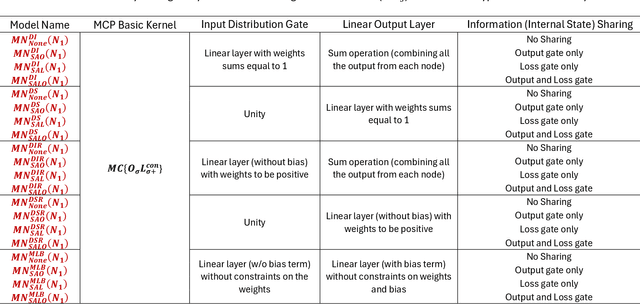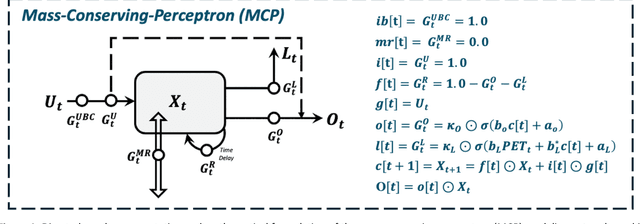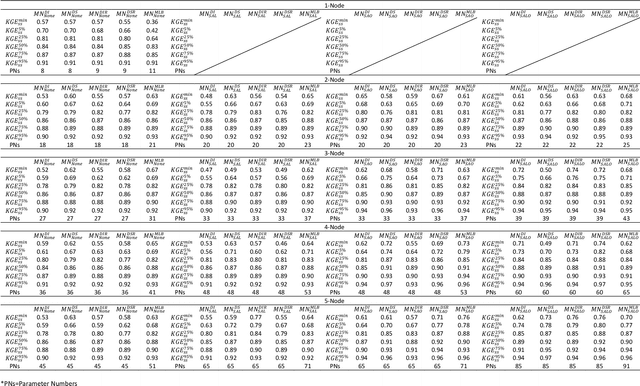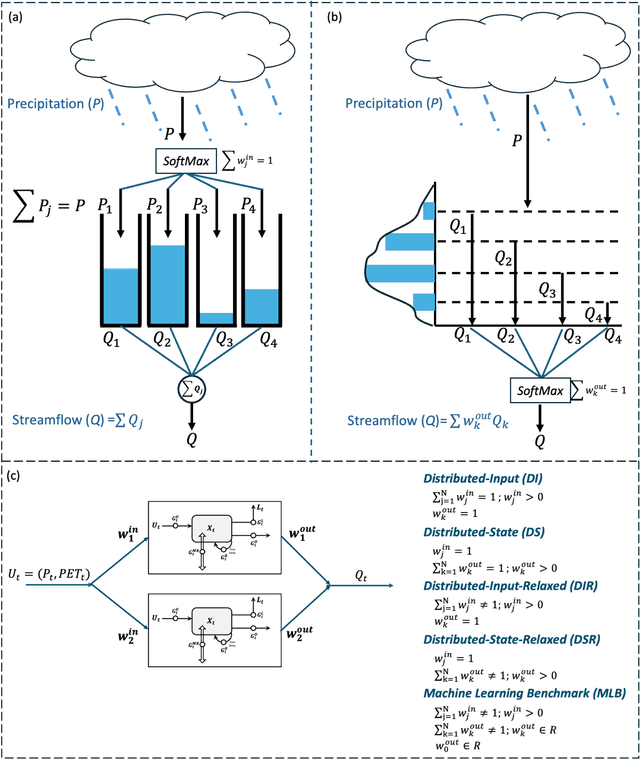Yuan-Heng Wang
Using Machine Learning to Discover Parsimonious and Physically-Interpretable Representations of Catchment-Scale Rainfall-Runoff Dynamics
Dec 06, 2024



Abstract:Despite the excellent real-world predictive performance of modern machine learning (ML) methods, many scientists remain hesitant to discard traditional physical-conceptual (PC) approaches due mainly to their relative interpretability, which contributes to credibility during decision-making. In this context, a currently underexplored aspect of ML is how to develop minimally-optimal representations that can facilitate better insight regarding system functioning. Regardless of how this is achieved, it is arguably true that parsimonious representations better support the advancement of scientific understanding. Our own view is that ML-based modeling of geoscientific systems should be based in the use of computational units that are fundamentally interpretable by design. This paper continues our exploration of how the strengths of ML can be exploited in the service of better understanding via scientific investigation. Here, we use the Mass Conserving Perceptron (MCP) as the fundamental computational unit in a generic network architecture consisting of nodes arranged in series and parallel to explore several generic and important issues related to the use of observational data for constructing input-state-output models of dynamical systems. In the context of lumped catchment modeling, we show that physical interpretability and excellent predictive performance can both be achieved using a relatively parsimonious distributed-state multiple-flow-path network with context-dependent gating and information sharing across the nodes, suggesting that MCP-based modeling can play a significant role in application of ML to geoscientific investigation.
Towards Interpretable Physical-Conceptual Catchment-Scale Hydrological Modeling using the Mass-Conserving-Perceptron
Jan 29, 2024Abstract:We investigate the applicability of machine learning technologies to the development of parsimonious, interpretable, catchment-scale hydrologic models using directed-graph architectures based on the mass-conserving perceptron (MCP) as the fundamental computational unit. Here, we focus on architectural complexity (depth) at a single location, rather than universal applicability (breadth) across large samples of catchments. The goal is to discover a minimal representation (numbers of cell-states and flow paths) that represents the dominant processes that can explain the input-state-output behaviors of a given catchment, with particular emphasis given to simulating the full range (high, medium, and low) of flow dynamics. We find that a HyMod-like architecture with three cell-states and two major flow pathways achieves such a representation at our study location, but that the additional incorporation of an input-bypass mechanism significantly improves the timing and shape of the hydrograph, while the inclusion of bi-directional groundwater mass exchanges significantly enhances the simulation of baseflow. Overall, our results demonstrate the importance of using multiple diagnostic metrics for model evaluation, while highlighting the need for designing training metrics that are better suited to extracting information across the full range of flow dynamics. Further, they set the stage for interpretable regional-scale MCP-based hydrological modeling (using large sample data) by using neural architecture search to determine appropriate minimal representations for catchments in different hydroclimatic regimes.
A Mass-Conserving-Perceptron for Machine Learning-Based Modeling of Geoscientific Systems
Oct 24, 2023Abstract:Although decades of effort have been devoted to building Physical-Conceptual (PC) models for predicting the time-series evolution of geoscientific systems, recent work shows that Machine Learning (ML) based Gated Recurrent Neural Network technology can be used to develop models that are much more accurate. However, the difficulty of extracting physical understanding from ML-based models complicates their utility for enhancing scientific knowledge regarding system structure and function. Here, we propose a physically-interpretable Mass Conserving Perceptron (MCP) as a way to bridge the gap between PC-based and ML-based modeling approaches. The MCP exploits the inherent isomorphism between the directed graph structures underlying both PC models and GRNNs to explicitly represent the mass-conserving nature of physical processes while enabling the functional nature of such processes to be directly learned (in an interpretable manner) from available data using off-the-shelf ML technology. As a proof of concept, we investigate the functional expressivity (capacity) of the MCP, explore its ability to parsimoniously represent the rainfall-runoff (RR) dynamics of the Leaf River Basin, and demonstrate its utility for scientific hypothesis testing. To conclude, we discuss extensions of the concept to enable ML-based physical-conceptual representation of the coupled nature of mass-energy-information flows through geoscientific systems.
 Add to Chrome
Add to Chrome Add to Firefox
Add to Firefox Add to Edge
Add to Edge